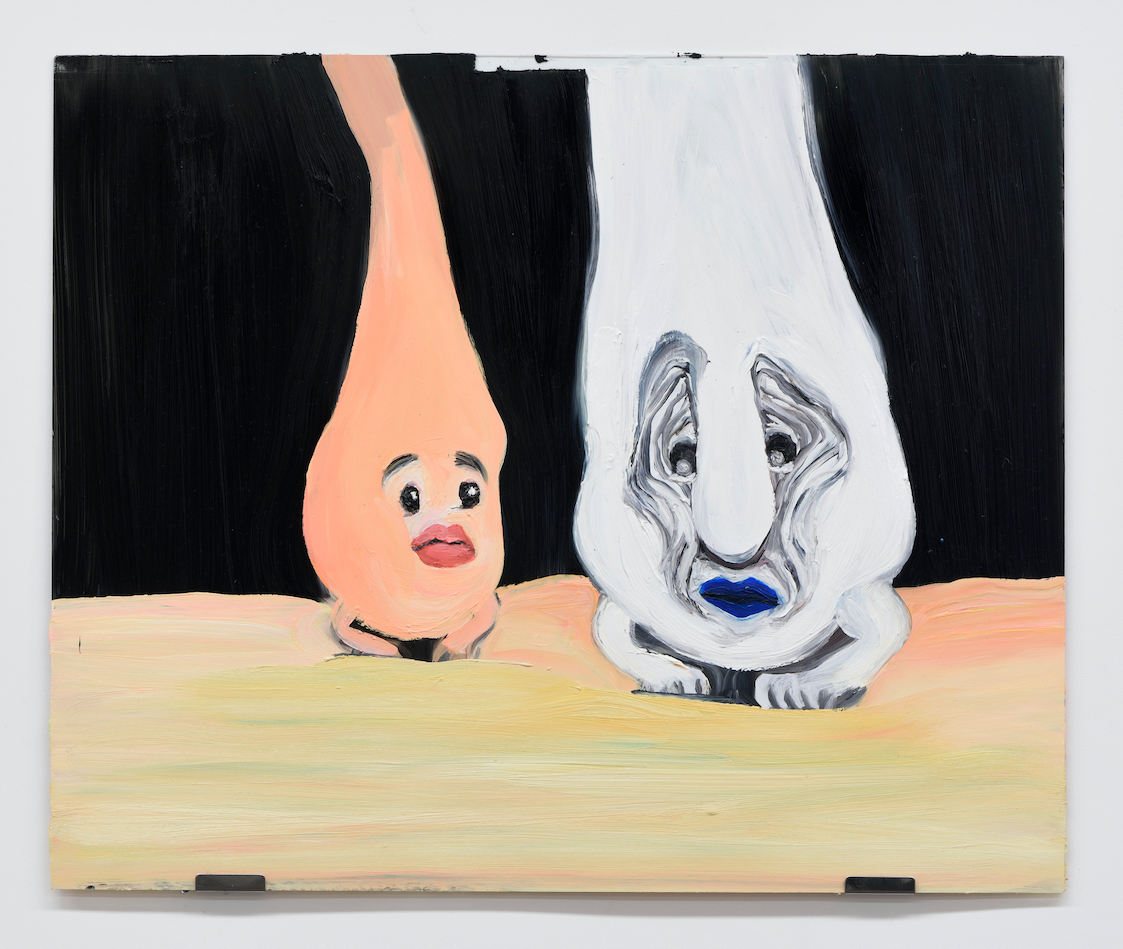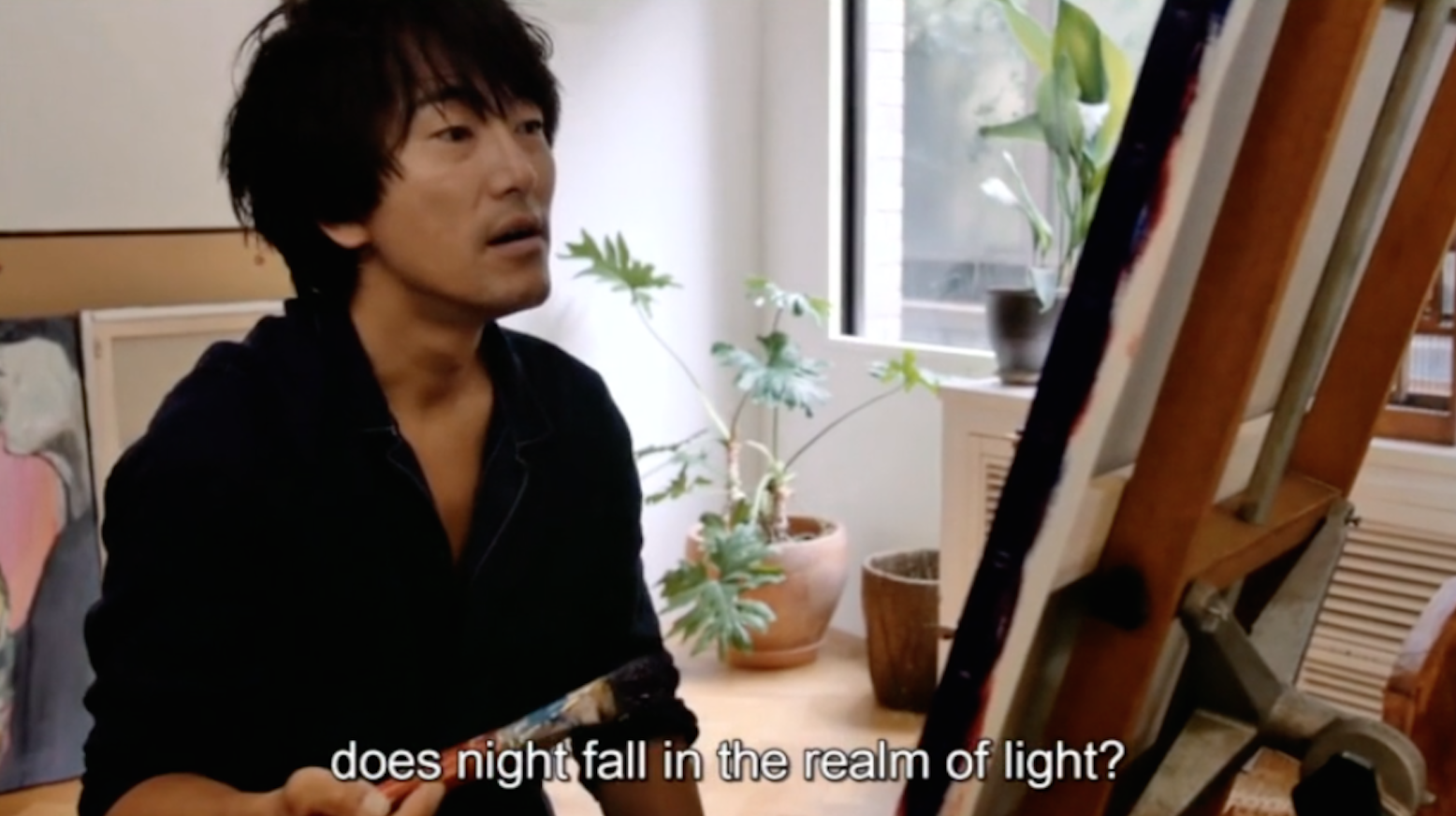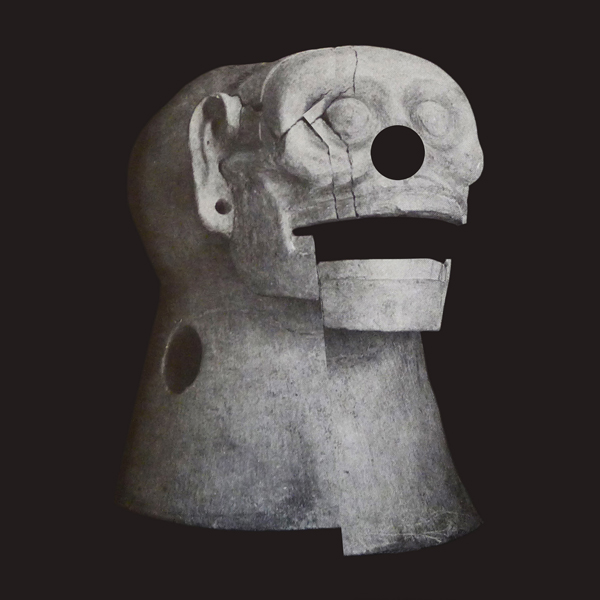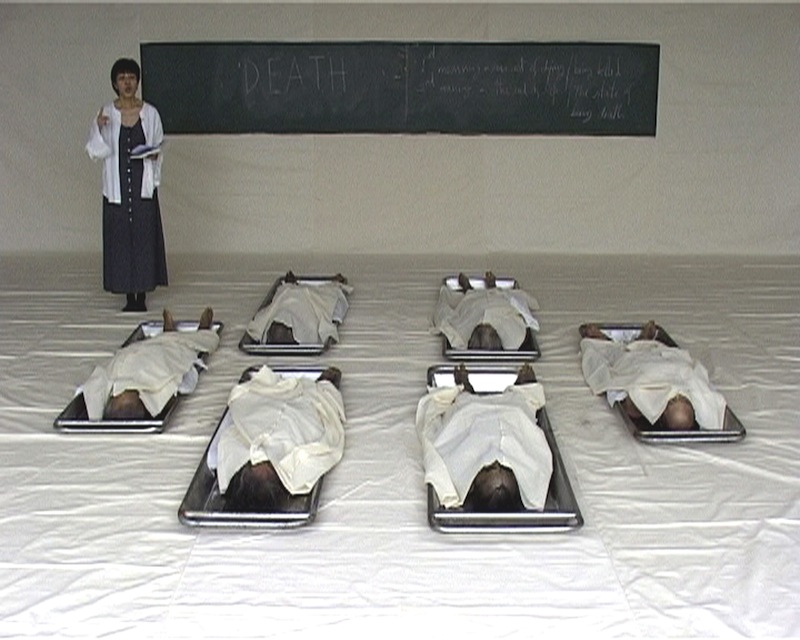
© » KADIST
Andrew Ekins
Butter Mountain is part of an ongoing series of works that combines a sense of painterly mass and substance with sculptural language to examine the synergy between a topographical landscape and a landscape of the human condition. The work intentionally alludes to the materiality of the human body and of the land. A stool has been consciously repurposed as a “support”, that by its nature and identity provides evidence of human presence.

© » KADIST
John Isaacs
A child and dreamer my whole life long (broken tree) (2004) is a sculpture made of filler, wire, copper, oil paint, and wood depicting a tree just at it’s moment of breaking into half – one part alive with foliage and blooming branches and the other the crisp of the break exposed, with the trunk adhered solidly to a plinth. The sculpture appears to speak quite bluntly about Isaac’s own sense of bleak pessimism when exposing a severed tree, the universe’s sacred sign of life and birth. Through the perfect rendering of this encapsulated moment, Isaacs demonstrates the strength of the sculptural artifact and his interest in failure and fragility.

© » KADIST
Aki Kondo
Mogeji’s Journey (2014) depicts three hand painted stills from an animated sequence in Aki Kondo’s film Hikari (Light) (2015). Kondo’s film tells the story of a young woman named Juneko who discovers that she is terminally ill and the ways that this impacts her lover, a painter, who tries to reconnect with her by painting her portrait from memory. As Juneko becomes sicker, her hair begins to fall out, a symptom of her unnamed illness.

© » KADIST
Aki Kondo
Hikari (Light) (2015) depicts a fantastical and wrenching story about Juneko, a terminally ill young woman who communicates with her lover, a painter, through a portrait of her produced shortly after her death. As Juneko becomes sicker, her hair begins to fall out, a symptom of her unnamed illness. As her condition deteriorates, the film toggles back and forth with the animated story of Mogeji, a white strand of hair inhabiting Juneko’s body who becomes anthropomorphized through Kondo’s animation and recounts his own story of mortality and loss.

© » KADIST
Michel François
Drawing & Print (Drawing & Print)
In Michel François’s work, « it is the real, physical and emotional experience that stimulates creation which is therefore highly charged with a vital force. There lies also the profoundly and clandestine figurative nature of his work » (Guillaume Désanges). Contamination is a constant in Michel François’s work.

© » KADIST
Ana Roldán
Ana Roldán’s Displacements works use images taken from a 1970s exhibition catalogue for an exhibition called The Death in Mexico. Using pre-Columbian objects and other artifacts from Mexican history, the exhibition aimed to explore various representations of death in the Mexican cultural tradition. Roldán’s works begin with these rich black-and-white photographs and break them apart into fragments, slicing and dismembering the artifacts they depict.

© » KADIST
Ian Breakwell
“BC/AD” (Before Cancer, After Diagnoses) is a video of photographs of the artist’s face dating from early childhood to the month before he died, accompanied by the last diary entries he wrote from April 2004 to July 2005 (entitled “50 Reasons for Getting Out of Bed”), from the period from when he lost his voice, thinking he had laryngitis, through the moment he was diagnosed with lung cancer and the subsequent treatment that was ultimately, ineffective. The diary entries are at once poignant, ironic, laced with gallows of humor, with his continued eye for the little incidents in life, interweaving the past with his experience of the present. The morphing of the portraits—the eyes and sight remaining leveled—is haunting, beginning with very blurry images of childhood and ending with a pin-sharp photograph of Breakwell the month before he died.

© » KADIST
Naoya Hatakeyama
Naoya Hatakeyama’s series Rikuzentakata (2011) documents the devastating aftermath of the 2011 Tohoku earthquake and tsunami in Japan. Throughout the series of sixty C-prints, Hatakeyama’s photographs depict scenes of torn landscapes and leveled homes, demolished villages and massive piles of detritus pummeled beyond recognition. The images serve as records of disaster, seemingly driven by an intense need to bear witness to collective trauma.

© » KADIST
Will Rogan
Will Rogan’s video Eraser (2014) shows a hearse parked in a clearing amidst leaf barren trees. The steely grey sky stands in stark contrast to the vehicle’s luminously pristine white finish and makes this already deathly object seem even more ghostly. The grass underneath is half-turned brown and further marks this as a lifeless landscape.

© » KADIST
Raymond Pettibon
The five works included in the Kadist Collection are representative of Pettibon’s complex drawings which are much more narrative than comics or cartoon. The images allude to recurring topics, such as the superhero (present both in Untitled Superman and No title without the comics ), a book cover (his literary sources), or a mushroom cloud. Inspired by the writings of William Faulkner, Daniel Defoe, Gustave Flaubert, Marcel Proust, and James Joyce, Pettibon’s sophisticated, witty drawings combine image and text to explore the gamut of American popular culture.

© » KADIST
Cerith Wyn Evans
Untitled (Perfect Lovers + 1) by Cerith Wyn Evans takes as its starting point Felix Gonzales-Torres’s seminal work Untitled (Perfect Lovers) , in which two clocks were synchronized and left to run without interference, the implication being that one would stop before the other. Gonzales-Torres’ original work was a personal allusion to his own partner’s increasingly debilitating HIV-related illness, which grapples with the existential tension of coexistence in the face of death. Cerith Wyn Evans’s piece takes the same concept, and adds a third clock, moving from the intimacy of a monogamous relationship to suggest a more expansive, or possibly polyamorous alternative.

© » KADIST
Araya Rasdjarmrearnsook
The Class (2005) by Araya Rasdjarmrearnsook challenges the viewer’s personal sense of morality and tolerance by depicting a classroom from hell. In the video, a woman, dressed in black with a white over shirt, stands in front of a long blackboard. The classroom’s rear walls and floor are covered in taut white fabric, given the room the sinister appearance of a sanitarium or a crime scene.
Aki Kondo
Aki Kondo utilizes animation, video, and mixed media to explore such varied topics as intimacy, loss, and the human body...
Cerith Wyn Evans
- location: London, United Kingdom
- year born: 1958
- gender: male
- nationality: British
- home town: Llanelli, United Kingdom
Araya Rasdjarmrearnsook
- location: Chiang Mai, Thailand
- year born: 1957
- gender: female
- nationality: Thai
- home town: Trad, Thailand
Raymond Pettibon
- location: Hermosa Beach, California
- year born: 1957
- gender: male
- nationality: American
- home town: Tucson, Arizona
Naoya Hatakeyama
- location: Iwate, Nihon
- year born: 1958
- gender: male
- nationality: Japanese
John Isaacs
John Isaacs’ work encompasses many different media, though much of it has origins in sculpture...
Ian Breakwell
- location: Derby, United Kingdom
- year born: 1943
- gender: male
- nationality: British
Andrew Ekins
Andrew Ekins’ work frequently deals with waste and recycling, using discarded materials to make something new...
Will Rogan
- location: Albany, California
- year born: 1975
- gender: male
- nationality: American
-
2000-2009
John Isaacs
2004A child and dreamer my whole life long (broken tree) (2004) is a sculpture made of filler, wire, copper, oil paint, and wood depicting a tree just at it’s moment of breaking into half – one part alive with foliage and blooming branches and the other the crisp of the break exposed, with the trunk adhered solidly to a plinth...
Michel François
Drawing & Print
2004(Drawing & Print) In Michel François’s work, « it is the real, physical and emotional experience that stimulates creation which is therefore highly charged with a vital force...
Raymond Pettibon
2005The five works included in the Kadist Collection are representative of Pettibon’s complex drawings which are much more narrative than comics or cartoon...
Araya Rasdjarmrearnsook
2005The Class (2005) by Araya Rasdjarmrearnsook challenges the viewer’s personal sense of morality and tolerance by depicting a classroom from hell...
Ian Breakwell
2008“BC/AD” (Before Cancer, After Diagnoses) is a video of photographs of the artist’s face dating from early childhood to the month before he died, accompanied by the last diary entries he wrote from April 2004 to July 2005 (entitled “50 Reasons for Getting Out of Bed”), from the period from when he lost his voice, thinking he had laryngitis, through the moment he was diagnosed with lung cancer and the subsequent treatment that was ultimately, ineffective...
Cerith Wyn Evans
2008Untitled (Perfect Lovers + 1) by Cerith Wyn Evans takes as its starting point Felix Gonzales-Torres’s seminal work Untitled (Perfect Lovers) , in which two clocks were synchronized and left to run without interference, the implication being that one would stop before the other...
-
2010-2019
Ana Roldán
2012Ana Roldán’s Displacements works use images taken from a 1970s exhibition catalogue for an exhibition called The Death in Mexico...
Will Rogan
2014Will Rogan’s video Eraser (2014) shows a hearse parked in a clearing amidst leaf barren trees...
Andrew Ekins
2018Butter Mountain is part of an ongoing series of works that combines a sense of painterly mass and substance with sculptural language to examine the synergy between a topographical landscape and a landscape of the human condition...